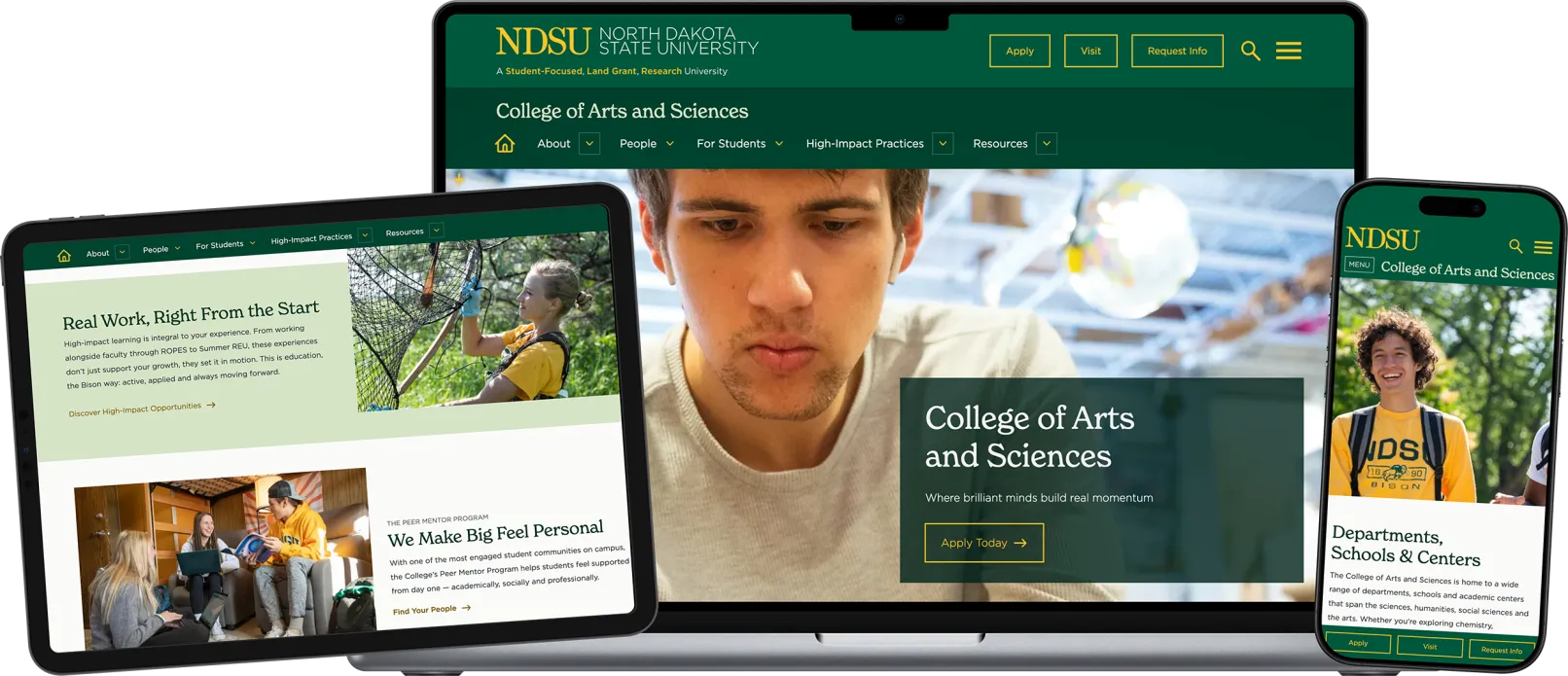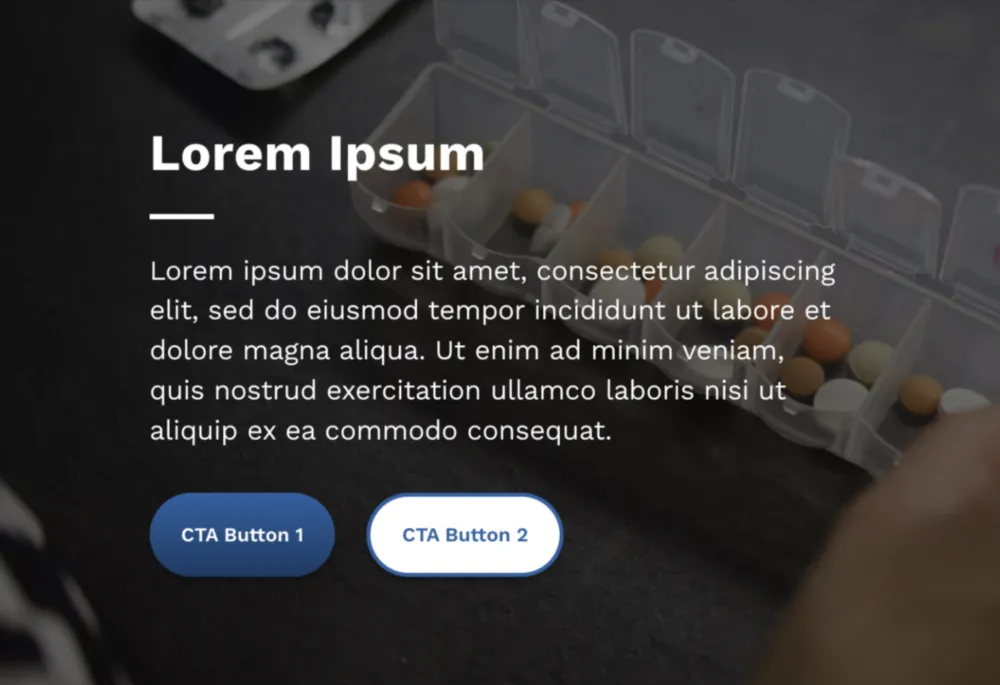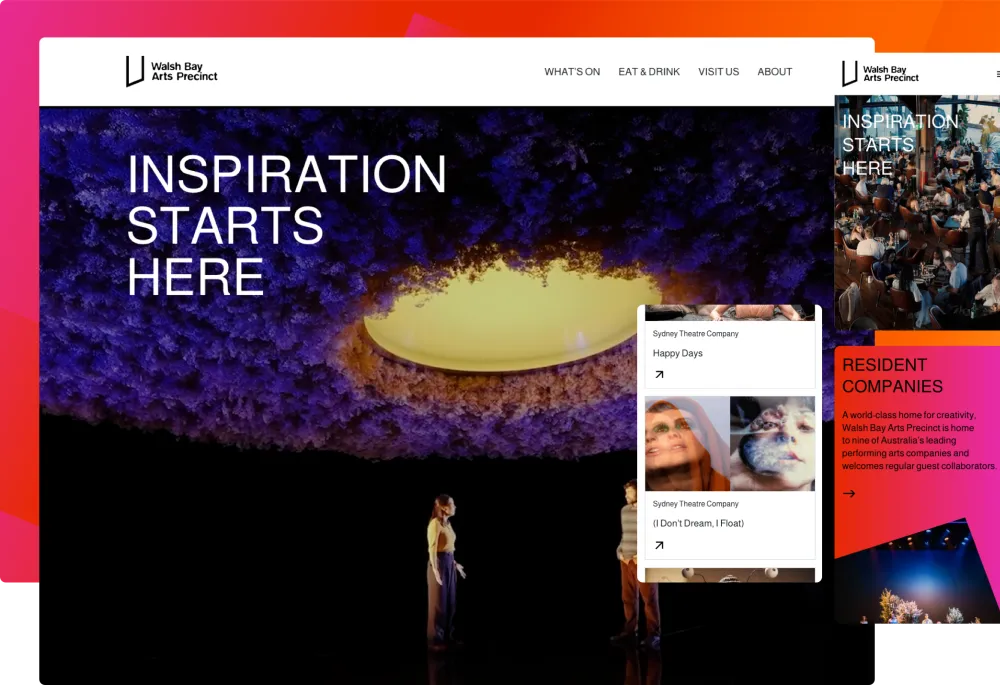Sector(s)
Team Members
In an increasingly competitive higher education landscape, North Dakota State University recognized the need to evolve — not incrementally, but boldly. Their brand vision, “One NDSU, One Voice,” called for a unified platform that could amplify the brand, support hundreds of editors, and provide a seamless experience for prospective students, families, and partners. But that transformation would mean untangling a complex web of nearly 300 independent sites, each with its own design, structure, and content.
Together with Four Kitchens, NDSU embraced the opportunity to leap forward — building a scalable, future-ready platform that brings their vision to life.
Empowering editors with an intuitive authoring experience
When your web platform supports more than 150 active content creators, it can’t just be powerful — it has to be intuitive. NDSU needed a publishing experience that could handle complexity behind the scenes while making content creation simple and flexible for editors across campus.
The new site revolutionizes the authoring experience. Built with Four Kitchens’ open-source design system, Emulsify, and the Layout Paragraphs module, NDSU’s interface provides drag-and-drop layout tools and real-time previews — no technical skills required. Editors can assemble content with confidence, knowing each variation automatically aligns with the University’s brand and accessibility standards.
By combining smart defaults with flexible components, we gave editors the best of both worlds: the freedom to tell their stories and the assurance that every page looks polished, professional, and on-brand. The result? Less time spent wrestling with layout, more time spent creating content that connects.
Fueling a community-led transformation
Great platforms don’t succeed without great people — and NDSU had a powerful, passionate community ready to lead the charge.
From day one, we partnered with NDSU’s stakeholders to build not just a better website, but a stronger sense of shared ownership and purpose. At the heart of that effort was the Web Principals group: 35 power users from across colleges and departments who served as project ambassadors, peer mentors, and essential links between central administration and distributed editors. These champions helped test features, refine training materials, and guide their colleagues through the platform transition.
 Four Kitchens led more than a dozen trainings on topics ranging from generative AI to “5 Tips for Creating Engaging Content” (shown here)
Four Kitchens led more than a dozen trainings on topics ranging from generative AI to “5 Tips for Creating Engaging Content” (shown here)
Together with the University Relations team, we developed a robust training and support network. 117 authors were trained in just two days, followed by weekly workshops, open office hours, and a comprehensive public knowledge base. These sessions covered everything from writing accessible content to using the new layout tools effectively.
The result is more than a trained editorial team. It’s a confident, connected community — aligned in purpose, empowered by tools, and supported by peers. And in bringing so many voices together, NDSU achieved the very vision that sparked this project: “One NDSU, One Voice.”
Editorial governance at scale
When you have more than 150 editors across dozens of colleges, departments, and offices, content freedom without control can quickly spiral into chaos. NDSU needed a way to empower its distributed teams while maintaining quality, security, and consistency across the entire platform.
We built a governance system rooted in Drupal’s Group module — a powerful permissions framework that mirrors NDSU’s organizational structure. Each group functions as an isolated content silo, assigning roles, access, and editorial boundaries based on department. Editors in the College of Engineering, for example, can fully manage their own pages but can’t view or edit content owned by the Graduate School. The result is clear ownership, focused access, and dramatically reduced risk of cross-departmental content conflicts.
But this model didn’t just preserve autonomy — it unlocked a new level of independence. Previously, some tasks required IT approval or intervention — not because of internal policy, but because the old CMS and its rigid permissions made self-service difficult or risky.
With the new Drupal platform, that bottleneck is gone. Granular permissions built into Groups ensure that editors can manage their own content — even full microsites — with the confidence that they won’t break anything or go off-brand.
The impact is both cultural and operational. Editors now have the tools — and the trust — to publish efficiently within a stable, secure framework. It also simplifies onboarding and support: Editors know exactly where they work, what they manage, and what they can’t touch. Combined with training and peer mentorship from the Web Principals group, this governance model ensures that editors can move quickly and confidently — without sacrificing brand integrity or system stability.
It’s a powerful example of how technology and training can work together to bring “One NDSU, One Voice” to life.
More engaging program discovery
For prospective students, finding the right academic program is everything. But on NDSU’s previous websites, that journey was often fragmented and confusing. Program information on the main university site was pulled directly from the catalog, where program descriptions weren’t always updated regularly, and it was sometimes too detailed or technical to appeal to prospective students. To fill the gap, many departments created their own program pages, leading to duplicated — and sometimes conflicting — content across the sites.
The new platform reimagines this experience from the ground up, focusing on the student experience first. We partnered with NDSU to design a visually rich, Netflix-style program finder that invites exploration and encourages action. Organized around compelling categories like “Pursue a Career with Purpose,” the finder allows students to browse academic offerings by interest — making discovery more intuitive and engaging from the start.

Each program page now lives in a central, consistently designed system that highlights what matters most: degree options, career outcomes, and an engaging and concise look at the program. Departments and colleges can now link to these shared pages instead of creating their own, reducing duplicate content, streamlining updates, and ensuring accuracy across the board.
With strategic crosslinking to admissions, financial aid, and campus life content — plus improved SEO, accessible design, and modern search tools — prospective students now enjoy a faster, clearer path to the programs that fit them best.
Migrating hundreds of sites — with some help from AI
Rebuilding a university-wide platform is no small feat. Rebuilding it while consolidating 296 legacy TYPO3 websites and two Drupal sites? That’s transformation on another level.
To make the migration both manageable and efficient, we deployed a strategic mix of automation, templating, and hands-on support. But the real accelerant? AI.
Two legacy AngularJS applications required significant rework to function within the new Drupal environment. Rather than rewrite them from scratch, we used AI-assisted tools to translate the codebase into clean, maintainable vanilla JavaScript — drastically reducing development time and allowing our team to focus on refinement and integration.
On the content side, we collaborated with NDSU to audit and triage their sprawling site network. Together, we built a prioritized migration plan aligned with the university’s recruitment goals — identifying which pages to rebuild, redirect, or retire. Editors were equipped to recreate their content using the new component system, supported every step of the way by robust governance resources and real-time coaching from Four Kitchens.
We didn’t just move content from old to new. We helped NDSU reimagine their digital ecosystem — faster, smarter, and with fewer barriers — thanks in part to the strategic use of AI.
Back to topFlexing with the brand: Navigating a simultaneous rebrand
While the web transformation was underway, NDSU was also rolling out a campus-wide brand refresh — a project with its own evolving timeline, stakeholder input, and creative direction. This could have easily derailed progress, but instead, it became an opportunity to build even stronger alignment.
Rather than treat branding as a late-stage polish, we built our work around it from day one. Our design system was flexible enough to accommodate changes to typography, color, photography, and voice as they emerged. We created reusable, on-brand components that could evolve in lockstep with the visual identity.
By partnering closely with NDSU’s University Relations team, we turned what could have been a constraint into a collaboration — ensuring the platform was always aligned with the latest brand vision, without sacrificing momentum or quality.

Results: A platform that performs, inspires, and unites
The new NDSU website offers a cohesive, engaging experience strategically aligned for recruitment and growth.
A unified digital identity. Successfully consolidated 296 TYPO3 and two Drupal sites into a single, centralized platform — turning a fragmented web ecosystem into a cohesive brand experience. For the first time, every college, department, and office now speaks with “One NDSU, One Voice,” reinforcing trust, clarity, and institutional pride across all digital touchpoints.
AI-accelerated modernization. Leveraging AI tools to refactor outdated AngularJS applications into clean JavaScript saved significant development time — allowing NDSU to modernize legacy systems without starting from scratch or increasing technical debt.
Faster, easier content creation. Intuitive, drag-and-drop authoring tools dramatically reduce time spent formatting and troubleshooting. Paired with live previews and smart defaults, the interface empowers editors to focus on what matters most: creating compelling content for their audiences.
Smarter authoring through design systems. Editors can create 324 unique layout permutations from just a handful of templates, colorways, and formatting options — and that doesn’t include the components library! It’s a powerful, scalable authoring system built on Emulsify and Layout Paragraphs that provides flexibility without sacrificing consistency or accessibility.
Empowered editors, sustainable governance. Through a strategic training program and the Web Principals initiative, more than 150 editors — including 35 campus champions — were trained to create compelling content with confidence. NDSU’s investment in people has fostered an active community of editors and authors.
Outstanding speed and performance. The new site achieves Lighthouse performance scores up to 99 on internal pages and delivers a homepage that loads in just 0.5 seconds — creating a faster, smoother experience that keeps users engaged and reduces bounce.
Dynamic academic discovery. A visually rich, Netflix-style program finder transforms how prospective students explore academic offerings. Organized by intuitive interest groups like “Shape the Future Through Innovation,” this tool makes program selection more engaging, personalized, and student-centered.
Elevated accessibility and SEO. Near-perfect accessibility and SEO scores ensure that NDSU’s content is inclusive, compliant, and discoverable. These improvements expand the reach of NDSU’s messaging while supporting recruitment, equity, and brand visibility goals.
Back to topFor years, NDSU’s web presence had grown organically — and unevenly. Nearly 300 websites existed across the institution, each created by different colleges, departments, and offices with varying styles and levels of quality. Some were built on outdated platforms. Many were difficult to navigate. Most needed updates to better reflect NDSU’s new brand and strategic priorities.
This patchwork approach diluted the University’s online identity, confused users, and made it difficult for the University Relations team to support editors or ensure consistent quality. Prospective students often encountered outdated or contradictory information, while internal teams struggled with redundant content and unclear ownership.
Further complicating matters was a concurrent university-wide rebranding effort. We faced a unique challenge: building the new website alongside an evolving brand identity.
To meet NDSU’s ambitious goals, we knew this project couldn’t be just a redesign — it had to be a reinvention. We didn’t start with comps or templates. We started by listening: to editors, to stakeholders, to students, and to the evolving brand itself.
From there, we built a flexible, future-ready Drupal platform designed to scale across hundreds of sites, serve the needs of dozens of departments, and support a diverse range of content creators. Every feature, every pattern, and every piece of guidance was created with one core principle in mind: Make it easier for NDSU to speak in one clear, confident voice — reinforcing their brand vision of “One NDSU, One Voice” — without sacrificing the autonomy of its teams.

Technical Specifications
Drupal version:
Key modules/theme/distribution used:



